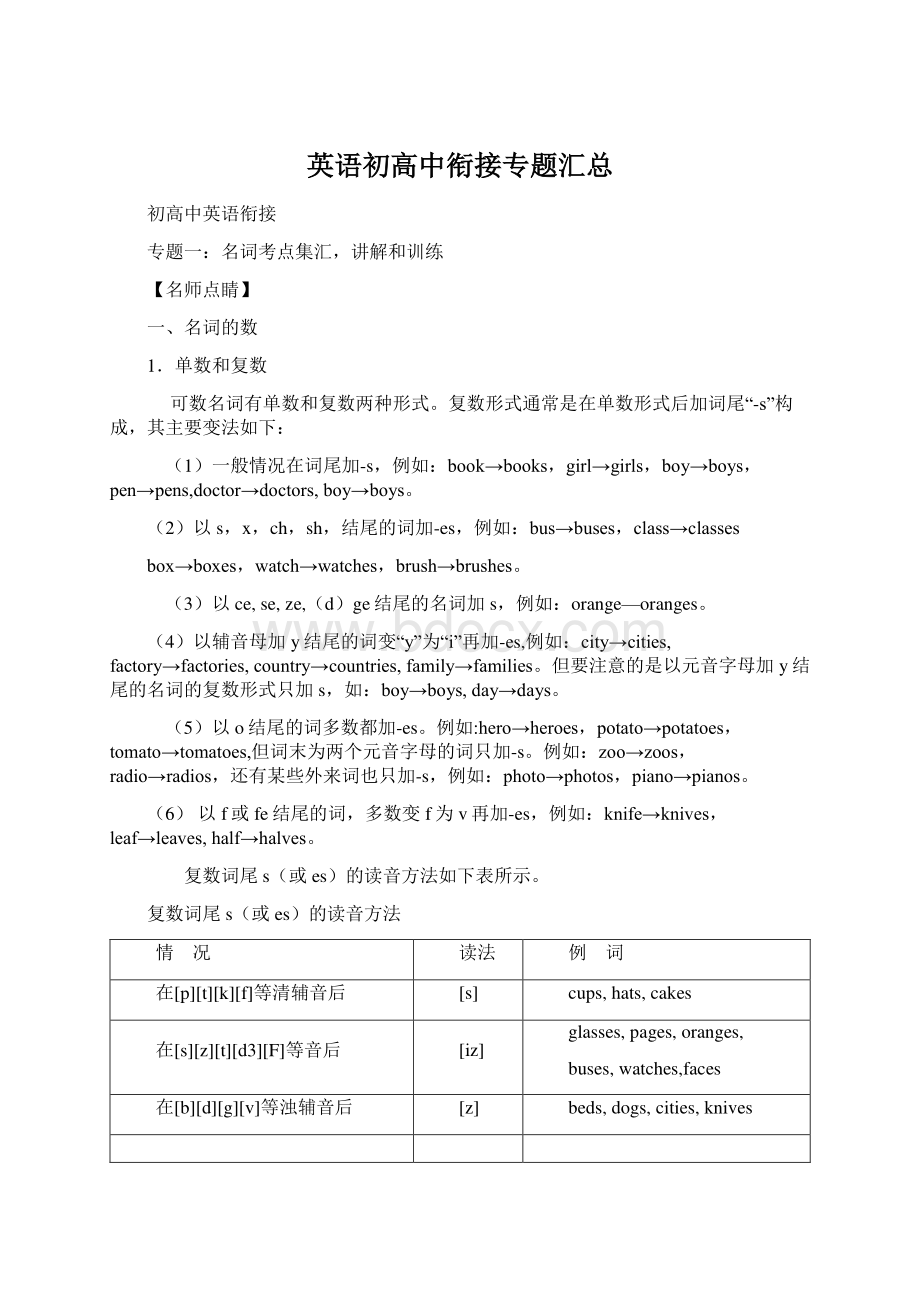英语初高中衔接专题汇总文档格式.docx
《英语初高中衔接专题汇总文档格式.docx》由会员分享,可在线阅读,更多相关《英语初高中衔接专题汇总文档格式.docx(82页珍藏版)》请在冰豆网上搜索。

例如:
heroheroes,potatopotatoes,tomatotomatoes,但词末为两个元音字母的词只加-s。
例如:
zoozoos,radioradios,还有某些外来词也只加-s,例如:
photophotos,pianopianos。
(6)以f或fe结尾的词,多数变f为v再加-es,例如:
knifeknives,leafleaves,halfhalves。
复数词尾s(或es)的读音方法如下表所示。
复数词尾s(或es)的读音方法情况读法例词在ptkf等清辅音后scups,hats,cakes在sztd3F等音后izglasses,pages,oranges,buses,watches,faces在bdgv等浊辅音后zbeds,dogs,cities,knives(7)少数名词有不规则的复数形式,例如:
manmen,womanwomen,toothteeth,footfeet,childchildren,mousemice。
【注意】与man和woman构成的合成词,其复数形式也是-men和-women。
anEnglishman,twoEnglishmen。
但German不是合成词,故复数形式为Germans;
man,woman等作定语时,它的单复数以其所修饰的名词的单复数而定,如:
menworkers,womenteachers。
有个别名词单复数一样,例如:
Chinese,Japanese,sheep,deer,fish等。
但当fish表示不同种类的鱼时,可以加复数词尾。
(8)单数形式但其意为复数的名词有:
people,police等。
(9)数词+名词作定语时,这个名词一般保留单数形式,中间加连字符。
例如an8-year-oldgirl,aten-milewalk。
(10)还有些名词仅有复数形式,如:
trousers,clothes,chopsticks,glasses,goods,ashes,scissors,compasses。
(11)只用作单数的复数形式的名词有:
科学名词:
physics,mathematics/maths游戏名称:
bowls专有名词:
theUnitedStates,NiagaraFalls其他名词:
news,falls2不可数名词“量”的表示方法在英语中,不可数名词如果要表示“量的概念”,可以用以下两种方法:
(1)用much,alittle,alotof/lotsof,some,any等表示多少,例如:
TherichmanhasalotofmoneyThereissomemilkinthebottleIsthereanywaterintheglass?
Idontlikewinterbecausetherestoomuchsnowandice
(2)用apieceof这类定语,例如:
apieceofpaperapieceofwoodapieceofbreadabottleoforangeaglassofwater(milk)acupofteaacupofteaabagofricethreebagsofrice如果要表示“两杯茶”、“四张纸”这类概念时,在容器后加复数,例如:
twocupsofteafourpiecesofpaperthreeglassesofwater不可数名词也可用alotof,lotsof,some,any,much等来修饰。
二、名词的所有格名词所有格,用来表示人或物的所有,以及领属关系。
1.表示有生命的名词的所有格其单数形式是加s,其复数形式是s,例如:
astudentsroom,studentsrooms,fathersshoes。
2.如其结尾不是s的复数形式仍加s,如:
ChildrensDay。
3.在表示时间、距离、长度、重量、价格、世界、国家等名词的所有格要用s,例如:
atwentyminuteswalk,tenmilesjourney,aboatslength,twopoundsweight,tendollarsworth。
4.无生命名词的所有格则必须用of结构,例如:
amapofChina,theendofthisterm,thecapitalofourcountry,thecoloroftheflowers。
5.双重所有格,例如:
afriendofmyfathers。
【注意】如果两个名词并列,并且分别有s,则表示“分别有”,例如:
JohnsandMarysrooms(约翰和玛丽各有一间,共两间);
TomsandMarysbikes(两人各自的自行车)。
两个名词并列,只有一个s,则表示“共有”,例如:
JohnandMarysroom(约翰和玛丽共有一间);
TomandMarysmother(即Tom与Mary是兄妹)。
【演练】1-Wherehaveyoubeen,Tim?
-Ivebeento_.A.theHenryhouseB.theHenryfamilyC.TheHenryshomeD.Henrys2InEngland,if_isinthemiddleoftheday,theeveningmealiscalledsupper.A.foodB.lunchC.breakfastD.dinner3Youlookedforittwice,butyouhaventfoundit.Whynottry_.A.threetimesB.athirdtimeC.thethirdtimeD.once4-Theyarethirsty.Willyoupleasegivethem_?
-Certainly.A.somebottlesofwatersB.somebottlesofwaterC.somebottleofwaterD.somebottleofwaters5Mikehurtoneofhis_intheaccidentyesterday.A.toothB.feetC.handD.ear6Thereissome_ontheplate.A.cakesB.meatC.potatoD.pears7InEngland,thelastnameisthe_.A.familynameB.middleC.givennameD.fullname8Theyaregoingtofly_toBeijing.A.GermenB.GermanyC.GermanysD.Germans9The_hastwo_.A.boys;
watchesB.boy;
watchC.boy;
watchesD.boys;
watch10Thelittlebabyhastwo_already.A.toothB.toothsC.teethD.teeths11Whatsyour_forbeinglateagain?
A.ideaB.keyC.excuseD.news12-Itsdangeroushere.Wedbettergooutquickly.-ButIthinkweshouldlet_gooutfirst.A.womanandchildrenB.womenandchildC.womanandchildD.womenandchildren13-YoucanseeMr.Smithifthereisasign“_”onthedoorofhisshop.-Thanks.A.ENTRANCEB.BUSINESSHOURSC.THISSIDEUPD.NOSMOKING14Aretheygoingtohaveapicnicon_?
A.ChildrensDayB.ChildrenssDayC.ChildrensDayD.ChildrenDay15Wherearethestudents?
Aretheyin_?
A.theRoom406B.Room406C.the406RoomD.406Room【练习答案】1.D2.B3.B4.B5.B6.B7.A8.D9.C10.C11.C12.D13.B14.A15.B专题二:
形容词、副词考点集汇,讲解和训练【名师点睛】1.形容词的用法
(1)形容词在句中作定语,表语,宾语补足语。
Ourcountryisabeautifulcountry.(作定语)Thefishwentbad.(作表语)Wekeepourclassroomcleanandtidy.(作宾语补足语)
(2)形容词修饰something,anything,nothing,everything等不定代词时,形容词放在名词后面。
Ihavesomethingimportanttotellyou.Isthereanythinginterestinginthefilm.(3)用and或or连接起来的两个形容词作定语时一般把它们放在被修饰的名词后面。
起进一步解释的作用。
Everybody,manandwoman,oldandyoung,shouldattendthemeeting.Youcantakeanyboxaway,bigorsmall.(4)the形容词表示一类人或物Therichshouldhelpthepoor.2.副词的用法
(1)副词在句中可作状语,表语和定语。
Hestudiesveryhard.(作状语)Lifehereisfullofjoy.(作定语)Whenwillyoubeback?
(作表语)副词按其用途和含义可分为下面五类:
1)时间副词时间副词通常用来表示动作的时间。
常见的时间副词有:
nowtoday,tomorrow,yesterday,before,late,early,never,seldom,sometimes,often,usually,always等。
Heoftencomestoschoollate.Whatarewegoingtodotomorrow?
HeisneverbeentoBeijing.2)地点副词地点副词通常用来表示动作发生的地点。
常见的地点副词有:
here,there,inside,outside,home,upstairs,downstairs,anywhere,everywhere,nowhere,somewhere,down,up,off,on,in,out等。
Imetanoldfriendofmineonmywayhome.Hewentupstairs.Putdownyournamehere.3)方式副词方式副词一般都是回答“怎样的?
”这类问题的,其中绝大部分都是由一个形容词加词尾-ly构成的,有少数方式副词不带词尾-ly,它们与形容词同形。
常见的方式副词有:
anxiously,badly,bravely,calmly,carefully,proudly,rapidly,suddenly,successfully,angrily,happily,slowly,warmly,well,fast,slow,quick,hard,alone,high,straight,wide等。
Theoldmanwalkedhomeslowly.Pleaselistentotheteachercarefully.Thebirdsareflyinghigh.Herunsveryfast.4)程度副词程度副词多数用来修饰形容词和副词,有少数用来修饰动词或介词短语。
常见的程度副词有:
much,(a)little,abit,very,so,too,enough,quite,rather,pretty,greatly,completely,nearly,almost,deeply,hardly,partly等。
Herpronunciationisverygood.Shesingsquitewell.Icanhardlyagreewithyou.5)疑问副词是用来引导特殊疑问句的副词。
常见的疑问副词有:
how,when,where,why等。
Howareyougettingalongwithyourstudies?
Wherewereyouyesterday?
Whydidyoudothat?
(2)副词在句中的位置1)多数副词作状语时放在动词之后。
如果动词带有宾语,则放在宾语之后。
MrSmithworksveryhard.ShespeaksEnglishwell.2)频度副词作状语时,通常放在行为动词之前,情态动词,助动词和be动词之后。
Heusuallygetsupearly.Iveneverheardhimsinging.Sheisseldomill.3)程度副词一般放在所修饰的形容词和副词的前面,但enough作副词用时,通常放在被修饰词的后面。
Itisaratherdifficultjob.Herunsveryfast.Hedidntworkhardenough.4)副词作定语时,一般放在被修饰的名词之后。
Onmywayhome,Imetmyuncle.Thestudentstherehavealottimetodotheirownresearchwork.(3)部分常用副词的用法1)very,much这两个副词都可表示“很”,但用法不同。
Very用来修饰形容词和副词的原级,而much用来修饰形容词和副词的比较级。
SheisaverynicegirlImfeelingmuchbetternow.Much可以修饰动词,而very则不能。
Idontliketheideamuch.Theydidnottalkmuch.2)too,either这两个副词都表示“也”,但too用于肯定句,either用于否定句。
Shecandance,andIcandance,too.Ihaventreadthebookandmybrotherhasnteither.3)already,yetalready一般用于语肯定句,yet一般用于否定句。
Hehasalreadyleft.Haveyouheardfromhimyet?
Hehasntansweredyet.4)so,neitherso和neither都可用于倒装句,但so表示肯定,neither表示否定。
MybrotherlikesfootballandsodoI.MybrotherdoesntlikedancingandneitherdoI.3.形容词和副词的比较级和最高级
(1)两个人或事物的比较时(不一定每一方只有一个人或一个事物),用比较级。
Ourteacheristallerthanweare.Theboysinherclassaretallerthantheboysinyourclass.
(2)most同形容词连用而不用the,表示极,很,非常,十分。
Itsmostdangeroustobehere.在这儿太危险。
(3)“The+形容词比较级.,the+形容词比较级.”表示“越.就越.”。
Themoreyoustudy,themoreyouknow.(4)“形容词比较级+and+形容词比较级”,表示“越来越.”。
Itsgettinghotterandhotter.(5)主语+谓语(系动词)+as+形容词原形+as+从句。
表示两者对比相同。
Thisboxisasbigasmine.(6)the+形容词,表示某种人。
Healwayshelpsthepoor.(7)形容词和副词最高级用于三个或三个以上的人和物进行比较。
ShanghaiisoneofthebiggestcitiesinChina.【演练】1Therearemanyyoungtreesonsidesoftheroad.A.everyB.eachC.bothD.all2-Itssocoldtoday.-Yes,itsthanitwasyesterday.A.morecoldB.morecolderC.muchcolderD.cold3LittleTomhasfriends,soheoftenplaysalone.A.moreB.alittleC.manyD.few4Sheisntsoatmathsasyouare.A.wellB.goodC.betterD.best5Peterwritesofthethree.A.betterB.bestC.goodD.well6Heisenoughtocarrytheheavybox.A.strongerB.muchstrongerC.strongD.thestrongest7Iboughtexercise-bookswithmoney.A.afew;
afewB.afew;
alittleC.alittle;
afewD.alittle;
alittle8Theboxisheavyforthegirlcarry.A.too;
toB.to;
tooC.so;
thatD.no;
to9Theiceinthelakeisaboutonemeter.Itsstrongenoughtoskateon.A.longB.highC.thickD.wide10WuLinranfasterthantheotherboysinthesportsmeeting.A.soB.muchC.veryD.too11.Jonelooksso_todaybecauseshehasgotan“A”inhermathstest.A.happyB.happilyC.angryD.angrily12.Thesmileonmyfathersfaceshowedthathewas_withme.A.sadB.pleasedC.angryD.sorry13.-Mum,couldyoubuymeadresslikethis?
-Certainly,wecanbuy_onethanthis,but_this.A.abetter;
betterthanB.aworse;
asgoodasC.acheaper;
asgoodasD.amoreimportant;
goodas14.-Thisdigitalcameraisreallycheap!
-The_thebetter.Imshortofmoney,yousee.A.cheapB.cheaperC.expensiveD.moreexpensive15.IfyouwanttolearnEnglishwell,youmustuseitas_aspossible.A.oftenB.longC.hardD.soon16.Paulhas_friendsexceptme,andsometimeshefeelslonely.A.manyB.someC.fewD.more17.Englishpeople_useMr.Beforeamansfirstname.A.neverB.usuallyC.oftenD.sometimes18.-OnemoresatellitewassentupintospaceinChinainMay.-Right.Thegovernmentspoke_that.A.highlyforB.highofC.wellofD.highlyof19.-Rememberthis,children._carefulyouare,_mistakesyouwillmake.-Weknow,MissGao.A.Themore;
themoreB.Thefewer;
themoreC.Themore;
thefewerD.Theless;
theless20.Ihave_todotoday.A.anythingimportantB.somethingimportantC.importantnothingD.importantsomething【练习答案】1.C2.C3.D4.B5.B6.C7.B8.A9.C10.B11.A12.B13.C14.B15.A16.C17.A18.D19.C20.B专题三:
动词考点集汇,讲解和训练1.动词的时态英语时态用共有十六种时态,其中常用的有8种,它们是:
一般现在时、一般过去时、一般将来时、现在进行时、现在完成时、过去进行时、过去完成时和过去将来时。
(1)一般现在时的基本用法1)经常性或习惯性的动作,常与表示频度的时间状语连用。
时间状语:
every,sometimes,at,onSundayIleavehomefor